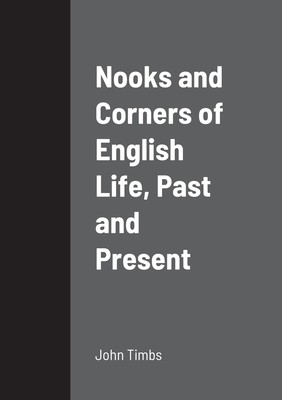
- We will send in 10–14 business days.
- Author: John Timbs
- Publisher: Lulu.com
- ISBN-10: 1458335720
- ISBN-13: 9781458335722
- Format: 14.8 x 21 x 1.2 cm, minkšti viršeliai
- Language: English
- SAVE -10% with code: EXTRA
Reviews
Description
Nooks and Corners of English Life, Past and Present by John TimbsIt has been well observed that the structure of a house reveals much of the mode of life adopted by its inhabitants. The representations of the dwellings of the people of the less cultivated parts of Europe, contrasted with those of the more cultivated countries, should afford us the means of comparing their different degrees of civilization. In the same manner we may measure the growth of improvement in any one country by an attentive consideration of the structure and arrangement of the homes of the people at different periods. The aboriginal Britons are described as dwelling in slight cabins of reeds and wattles, and in some instances in caverns of the earth, many sets of which, arranged with some degree of symmetry, antiquaries have recognised but Cæsar tells us that the maritime tribes had buildings in the fashion of the Gauls-that is, of wood, of a circular figure, and thatched. Such towns as they had were clusters of huts erected on a cleared portion of the forest, which covered the greater part of the island and they were invariably surrounded by a rampart, constructed of felled trees strongly interlaced and wattled, and a deep fosse, which together formed a fortification. The site of the modern city of London, with the river Thames in front, the river Fleet on the west, and an almost inpenetrable forest in the rear, may be taken as a fair specimen of the locality usually selected for the residence of the British Chief[That our ancestors lived in caves is attested by the existence of a group of these abodes near Penzance, the most remarkable of all ancient British Caves hitherto discovered in Cornwall, and thus described by Mr. J. Edwards, to the Royal Institution of that county: -"Half of a mile W.S.W. of Caër Bran, and four and a half miles W. by S. of Penzance, there is, in the village of Chapel Euny, a cave, consisting for the most part of a deep trench, walled with stones, and roofed with huge slabs. It extends 30 feet from N.N.W. to S.S.E., and then branches eastward, and probably also to the S. or S.W. So far it accords with the description of an ordinary British cave.
EXTRA 10 % discount with code: EXTRA
The promotion ends in 22d.04:05:27
The discount code is valid when purchasing from 10 €. Discounts do not stack.
- Author: John Timbs
- Publisher: Lulu.com
- ISBN-10: 1458335720
- ISBN-13: 9781458335722
- Format: 14.8 x 21 x 1.2 cm, minkšti viršeliai
- Language: English English
Nooks and Corners of English Life, Past and Present by John TimbsIt has been well observed that the structure of a house reveals much of the mode of life adopted by its inhabitants. The representations of the dwellings of the people of the less cultivated parts of Europe, contrasted with those of the more cultivated countries, should afford us the means of comparing their different degrees of civilization. In the same manner we may measure the growth of improvement in any one country by an attentive consideration of the structure and arrangement of the homes of the people at different periods. The aboriginal Britons are described as dwelling in slight cabins of reeds and wattles, and in some instances in caverns of the earth, many sets of which, arranged with some degree of symmetry, antiquaries have recognised but Cæsar tells us that the maritime tribes had buildings in the fashion of the Gauls-that is, of wood, of a circular figure, and thatched. Such towns as they had were clusters of huts erected on a cleared portion of the forest, which covered the greater part of the island and they were invariably surrounded by a rampart, constructed of felled trees strongly interlaced and wattled, and a deep fosse, which together formed a fortification. The site of the modern city of London, with the river Thames in front, the river Fleet on the west, and an almost inpenetrable forest in the rear, may be taken as a fair specimen of the locality usually selected for the residence of the British Chief[That our ancestors lived in caves is attested by the existence of a group of these abodes near Penzance, the most remarkable of all ancient British Caves hitherto discovered in Cornwall, and thus described by Mr. J. Edwards, to the Royal Institution of that county: -"Half of a mile W.S.W. of Caër Bran, and four and a half miles W. by S. of Penzance, there is, in the village of Chapel Euny, a cave, consisting for the most part of a deep trench, walled with stones, and roofed with huge slabs. It extends 30 feet from N.N.W. to S.S.E., and then branches eastward, and probably also to the S. or S.W. So far it accords with the description of an ordinary British cave.


Reviews